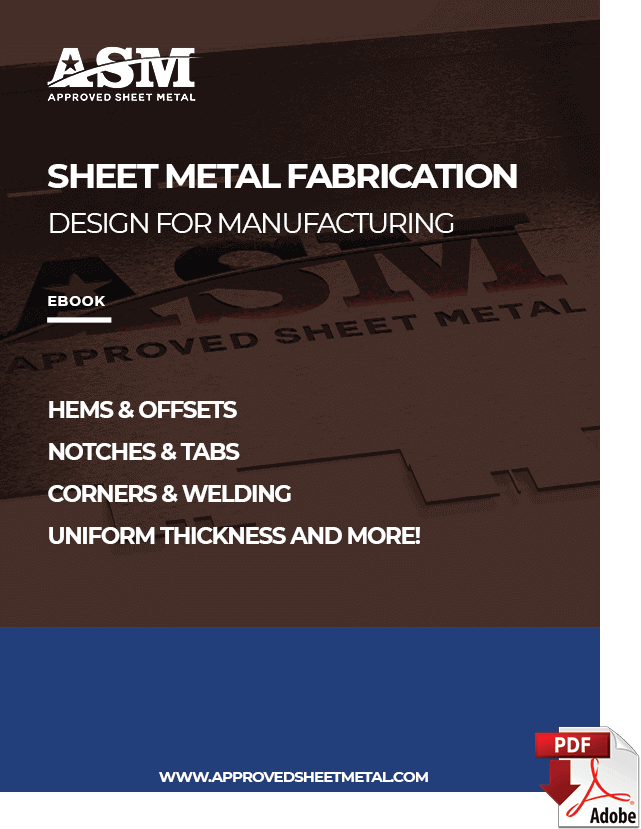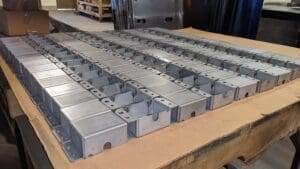Last updated on March 11th, 2025 at 09:05 am
Do you need support designing countersinks into your custom fabrication?
Countersinks are conical holes cut or formed into precision sheet metal parts that allow hardware to sit flush with the material. Here’s everything you need to know about designing countersinks, including Approved Sheet Metal’s proprietary formula for getting countersinks right every time.
Table of Contents
- 1 Important Countersink Measurements
- 2 Different Types of Countersinks
- 3 Hardware Determines Countersink Angles
- 4 Material-Specific Considerations for Countersinks
- 5 Our Proprietary SOLIDWORKS sheet metal Formula for Correct Countersink Measurements
- 6 Sheet Metal Design for Manufacturing
- 7 Sheet Metal Countersink FAQ
- 7.0.1 What are countersinks in precision sheet metal parts, and why are they important?
- 7.0.2 What are the key dimensions to consider when designing countersinks?
- 7.0.3 What are the standard angles used in countersink designs and their applications?
- 7.0.4 What are the main approaches for applying countersinks to parts, and how do they differ?
- 7.0.5 How does hardware selection impact countersink angles and measurements?
Important Countersink Measurements
There are three dimensions to understand when it comes to countersinks:
- Major: the larger diameter at the top of the opening, where the screw head will sit
- Minor: the smaller diameter at the bottom of the opening
- Angle: the angle of the screw or rivet head

The standard angles used in countersink designs are:
- 82° for screws in American manufacturing
- 90° for ISO 9001:2015 parts
- 100° for fasteners in the aerospace industry
- 120° for rivets
Different Types of Countersinks
When applying countersinks to a part, there are two main approaches:
1. Machined countersinks
Machined or "cut" countersinks are made using a drill press, end mill, or Bridgeport. First, a laser cuts the through-hole to the exact size of the minor dimension. Then, a drill bit spins into the material and makes the conical hole required to fit the hardware. As the drill bit comes down, it self-locates onto the hole and adheres to the programmed measurements.
Cutting countersinks is excellent for prototypes and low volume orders (less than 50) as machinists have to cut each countersink separately. While the setup is quick and no tooling is required, it’s only possible to make two countersinks per minute using this method.
2. Formed countersinks
Formed countersinks are made using a CNC punch press or turret press for the entire operation—no laser cutting or manual machining is necessary.
First, a hole is punched through the material resulting in a slightly bigger minor measurement. Using a process called "coining," a die, shaped like the screw used in the end product, is then punched through. The resulting pressure moves material downward toward the bottom opening of the hole. This material is repositioned at the bottom opening, reducing the diameter of the minor to achieve its correct size. The screw is punched in at this step.
Hardware Determines Countersink Angles
It’s important to select hardware for your project before you start thinking about countersinks, as the hardware's type, size, and material will determine your next steps. Make sure your fastener isn't going to collide with the mating part below it.
These factors will dictate the angles and measurements necessary for your minor and major.
You'll know the optimal angle based on the screw you select, but keep material thickness in mind. For thin materials, choose a wider angle and consider undercut hardware for added security.
Material-Specific Considerations for Countersinks
When designing countersinks in sheet metal, the choice of material significantly impacts manufacturability, durability, and overall performance. Different materials respond differently to machining and forming processes, influencing factors like burr formation, work-hardening, and dimensional stability.
1. Aluminum (5052, 6061, etc.)
- Machined Countersinks: Aluminum is relatively soft, making it easy to machine. However, 6061 aluminum is more brittle than 5052, increasing the risk of chipping at the edges of the countersink.
- Formed Countersinks: Due to its ductility, 5052 aluminum forms well without excessive stress. However, extra attention is needed to prevent deformation in thinner sheets.
✅ Best Practices: Use sharp tools when machining to avoid tearing. When forming, ensure the material is thick enough to retain its shape without excessive thinning.
2. Stainless Steel (304, 316, etc.)
- Machined Countersinks: Stainless steel is harder and more resistant to cutting, which can cause tool wear. Work-hardening is a common issue, requiring slower speeds and lubrication during machining.
- Formed Countersinks: Stainless steel does not flow as easily as aluminum, making it harder to form without cracking. 304 stainless is more formable than 316 stainless, which is tougher and more resistant to deformation.
✅ Best Practices: Use carbide tooling with coolant for machining. When forming, consider increasing the pre-punch hole size to reduce stress.
3. Mild Steel & Cold-Rolled Steel (CRS)
- Machined Countersinks: Cold-rolled steel machines well, but burr formation can be more pronounced compared to aluminum. Proper deburring is necessary to ensure a smooth finish.
- Formed Countersinks: CRS is highly formable, making it one of the best materials for formed countersinks. However, galvanized or coated steels may develop cracks in the coating during forming.
✅ Best Practices: If using galvanized steel, avoid formed countersinks to prevent coating damage.
4. High-Strength & Hardened Steels
- Machined Countersinks: Harder steels require slower cutting speeds and specialized tooling (such as cobalt or carbide drills).
- Formed Countersinks: Generally not recommended due to the material’s low ductility, which can lead to cracking.
✅ Best Practices: Consider machining instead of forming for hardened materials. If forming is necessary, use a larger bend radius to reduce stress.
5. Titanium & Exotic Alloys
- Machined Countersinks: Titanium and aerospace alloys are difficult to cut due to their strength and heat resistance. High tool wear and thermal buildup are concerns.
- Formed Countersinks: Not recommended for most exotic alloys, as they tend to crack or resist deformation.
✅ Best Practices: Use low-speed, high-torque drilling with lubrication for machining. For aerospace applications, follow industry-specific guidelines for countersink depth and tolerances.
By understanding how each material behaves during machining and forming, engineers can design stronger, more reliable countersinks while avoiding manufacturing challenges. When in doubt, consulting with a fabricator early in the design phase can help ensure optimal material selection and processing methods.
Our Proprietary SOLIDWORKS sheet metal Formula for Correct Countersink Measurements
If you've read our blog before, you probably know that we are SOLIDWORKS® enthusiasts here at Approved Sheet Metal. But keep in mind that SOLIDWORKS® won't always check your work, and you might design a countersink that isn’t easily manufacturable.
For example, if you pick out a material thickness that your minor dimension can't get to, or you have a 120° diameter going into a vertical edge, SOLIDWORKS® won't flag it for being impossible to make.
Our team can plug your design into SOLIDWORKS® and figure out the measurements for you using our proprietary formula. If you want to do it yourself, use our formula that increases the minor diameter to ensure a 0.005" flat edge so you can get measurements that will work with your part.
Our Countersink Formula: Pre-Punch Hole Size = B – [(B – C) x .75]
In our formula, "B" is the largest opening at the top of the countersink, and "C" is the desired opening at the bottom.
Not paying close attention to the diameters could result in a burr that prevents mating parts from sitting flat next to one another.
Countersinks are necessary in sheet metal fabrication, and designing them doesn't have to be challenging. If you would like a precision sheet metal expert to guide you through the process of creating countersinks, please get in touch with us!
And if you're ready to start your next sheet metal fabrication project, we'd love to show you what we can do. Request a quote to get started today.





